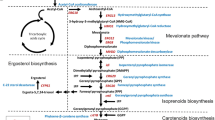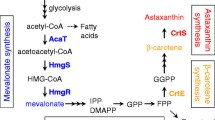Abstract
Xanthophyllomyces dendrorhous (Phaffia rhodozyma) is the only yeast or fungus that synthesizes the commercially attractive carotenoid astaxanthin. For a suitable bioprocess, the wild type has to be modified for increasing biomass content. To achieve this, a two step strategy has been followed. At first, random mutagenesis was applied leading to colonies with substantially higher astaxanthin content. Then, the resulting strain was genetically engineered by targeting limiting reactions for further enhancement of astaxanthin biosynthesis. This combinatorial approach together with selection of an appropriate growth medium resulted in highest astaxanthin biomass contents reported to date for X. dendrorhous. In a fermenter culture, its maximum content was 9.7 mg/g dry weight.


Similar content being viewed by others
References
Breitenbach J, Visser H, Verdoes JC, van Ooyen AJ, Sandmann G (2011) Engineering of geranylgeranyl pyrophosphate synthase levels and physiological conditions for enhanced carotenoid and astaxanthin synthesis in Xanthophyllomyces dendrorhous. Biotechnol Lett 33:755–761
de Boer L, Van Hell B, Krouwer AJJ (1993) Strains of Phaffia rhodozyma containing high levels of astaxanthin and low levels of 3-hydroxy-3′,4′-didehydro-beta-ψ-caroten-4-one (HDCO). US patent 5648261
de la Fuente JL, Rodríguez-Sáiz M, Schleissner C, Díez B, Peiro E, Barredo JL (2010) High-titer production of astaxanthin by the semi-industrial fermentation of Xanthophyllomyces dendrorhous. J Biotechnol 148:144–146
Gritz L, Davies J (1983) Plasmid-encoded hygromycin B resistance: the sequence of hygromycin B phosphotransferase gene and its expression in Escherichia coli and Saccharomyces cerevisiae. Gene 25:179–188
Guerin M, Huntley ME, Olaizola M (2003) Haematococcus astaxanthin: applications for human health and nutrition. Trends Biotechnol 21:210–216
Kim JH, Kang SW, Kim SW, Chang HI (2005) High-level production of astaxanthin by Xanthophyllomyces dendrorhous mutant Jh1 using statistical experimental designs. Biosci Biotechnol Biochem 69:1743–1748
Ojima K, Breitenbach J, Visser H, Setoguchi Y, Tabata K, Hoshino T, van den Berg J, Sandmann G (2006) Cloning of the astaxanthin synthase gene from Xanthophyllomyces dendrorhous (Phaffia rhodozyma) and its assignment as a beta-carotene 3-hydroxylase/4-ketolase. Mol Genet Genomics 275:148–158
Rodriguez-Saiz M, de la Fuente JL, Barredo JL (2010) Xanthophyllomyces dendrorhous for the industrial production of astaxanthin. Appl Microbiol Biotechnol 88:645–658
Schmidt I, Schewe H, Gassel S, Jin C, Buckingham J, Hümbelin M, Sandmann G, Schrader J (2011) Biotechnological production of astaxanthin with Phaffia rhodozyma/Xanthophyllomyces dendrorhous. Appl Microbiol Biotechnol 89:555–571
Schroeder WA, Johnson EA (1995) Singlet oxygen and peroxyl radicals regulate carotenoid biosynthesis in Phaffia rhodozyma. J Biol Chem 270:18374–18379
Verdoes JC, Krubasik KP, Sandmann G, van Ooyen AJ (1999) Isolation and functional characterisation of a novel type of carotenoid biosynthetic gene from Xanthophyllomyces dendrorhous. Mol Gen Genet 262:453–461
Verdoes JC, Sandmann G, Visser H, Diaz M, van Mossel M, van Ooyen AJ (2003) Metabolic engineering of the carotenoid biosynthetic pathway in the yeast Xanthophyllomyces dendrorhous (Phaffia rhodozyma). Appl Environ Microbiol 69:3728–3738
Villadsen IS (1992) A method of generating high carotenoid-producing microorganisms, microorganisms obtained by the method, and a process for producing carotenoid-containing cells or cell parts or purified carotenoid. International patent: WO 92/22648
Visser H, Sandmann G, Verdoes JC (2005) Xanthophylls in fungi: Metabolic engineering of the astaxanthin biosynthetic pathway in Xanthophyllomyces dendrorhous. Methods in biotechnology. Microbial processes and products. Humana, Totowa
Acknowledgments
This work was funded by the German Federal Ministry of Education and Research (BMBF) (FKZ 0315327).
Author information
Authors and Affiliations
Corresponding author
Rights and permissions
About this article
Cite this article
Gassel, S., Schewe, H., Schmidt, I. et al. Multiple improvement of astaxanthin biosynthesis in Xanthophyllomyces dendrorhous by a combination of conventional mutagenesis and metabolic pathway engineering. Biotechnol Lett 35, 565–569 (2013). https://doi.org/10.1007/s10529-012-1103-4
Received:
Accepted:
Published:
Issue Date:
DOI: https://doi.org/10.1007/s10529-012-1103-4




